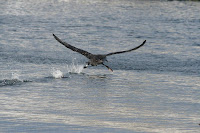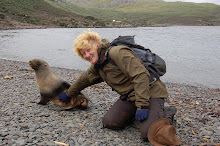
Sunshine recorder and wind instrument on top of the communications tower - recording some fine weather for a change!

Prince House, our main accommodation building

Stacey and Derren carry out some maintenance on the met instruments

Freshwater Inlet, with the base and mountain behind

A giant petrel taking off from the water

Northern giant petrel

Sleeping seals covered in wind-blown snow

A young blue-eyed shag on a rock

A female fur seal rejecting the males untimely advances

A young male seal enjoying the sun

When fur seals sleep they often tuck their flippers in around themselves


The fur seals seem much more relaxed when the sun shines!
Thus far this winter the weather has been, in general, appalling. The not-insignificant amount of snow that has fallen has either thawed soon after, or has been blown away by southerly gales, over the cliff edge on the north side of the island, only to melt into nothingness when it lands upon the sea once again. We have had days of fog, more commonly associated with the summer.
Dreams of long cold spells with clear skies, like Derren, Fabrice, Flea and I experienced last winter, have led to weeks of frustration - skis staying in storage, snow shoes gathering dust... but in the last few days, as we approach August, we have seen signs of a change. A couple of days of sunshine and snow showers have left the place with a far more wintery feel.
Today, with temperatures well below freezing and the bright sun shining down on us, was hopefully the beginning of a memorable period of fine winter weather, which will allow us plenty chances to get out and ski and enjoy the place at its best.







































